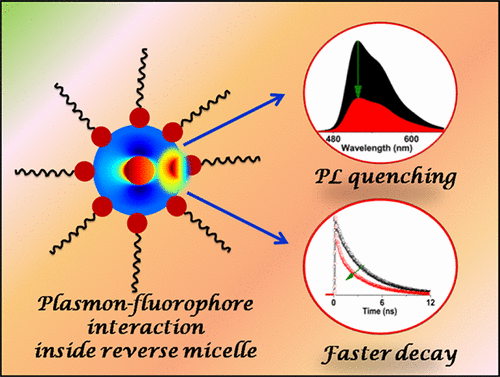Our official English website, www.x-mol.net, welcomes your feedback! (Note: you will need to create a separate account there.)
Coupling of Molecular Transition with the Surface Plasmon Resonance of Silver Nanoparticles inside the Restricted Environment of Reverse Micelles
ACS Omega ( IF 4.1 ) Pub Date : 2017-09-06 00:00:00 , DOI: 10.1021/acsomega.7b00902 Debabrata Singha 1 , Dillip Kumar Sahu 1 , Kalyanasis Sahu 1
ACS Omega ( IF 4.1 ) Pub Date : 2017-09-06 00:00:00 , DOI: 10.1021/acsomega.7b00902 Debabrata Singha 1 , Dillip Kumar Sahu 1 , Kalyanasis Sahu 1
Affiliation

|
Interaction of molecular transitions of two fluorophores—fluorescein (FL) and safranin O (SAF)—with the surface plasmon resonance (SPR) of silver nanoparticles (AgNPs) inside a water/sodium dioctylsulfosuccinate (AOT)/n-heptane reverse micelle (RM) has been studied using ultraviolet–visible and fluorescence spectroscopies. Here, we exploit the natural capacity of a RM to act simultaneously as a template for nanoparticle formation and host the fluorophores. The fluorophores and reducing agent were loaded together into the water pool; thereafter, silver salt was added, and subsequently, spectral modification and size evolution were monitored by steady-state and time-resolved optical spectroscopy. In the FL–AgNP composite, the SPR band of AgNPs undergoes a strong red shift. Moreover, significant modifications of both the fluorescence intensity and lifetime of FL were found when AgNPs formed inside the RM core. On the contrary, in the SAF–AgNP composite, no such effect was noticed, and the composite system retains the original optical characteristics of their constituents (i.e., both the position of molecular transitions and SPR maximum remain unchanged). This differential effect has been rationalized by the dissimilar plasmon–fluorophore coupling in the two systems, controlled by a combination of spatial distribution and spectral detuning of the molecular absorption maxima of the dyes (455 and 530 nm for FL and SAF, respectively) from the SPR band maximum (∼400 nm) of AgNPs.
中文翻译:

反向胶束受限环境内银纳米粒子的分子跃迁与表面等离子体共振的耦合
水/二辛基磺基琥珀酸钠(AOT)/ n中的两个纳米荧光团(荧光素(FL)和番红O(SAF))的分子跃迁与银纳米颗粒(AgNP)的表面等离子体共振(SPR)的相互作用-庚烷反胶束(RM)已使用紫外可见光谱和荧光光谱学进行了研究。在这里,我们利用RM的天然能力同时充当纳米颗粒形成的模板并容纳荧光团。将荧光团和还原剂一起加载到水池中。此后,加入银盐,随后,通过稳态和时间分辨光谱法监测光谱变化和尺寸演变。在FL-AgNP复合材料中,AgNPs的SPR带经历了强烈的红移。此外,当在RM核心内部形成AgNP时,发现FL的荧光强度和寿命都有显着改变。相反,在SAF-AgNP复合材料中,没有发现这种影响,并且该复合系统保留了其成分的原始光学特性(即,分子跃迁的位置和SPR最大值均保持不变)。两种系统中不同的等离激元-荧光团偶联已合理化了这种差异效应,该控制是通过空间分布和光谱分子对染料最大吸收量(分别为FL和SAF的455和530 nm)的光谱失谐控制的。 AgNP的SPR谱带最大值(约400 nm)。
更新日期:2017-09-06
中文翻译:

反向胶束受限环境内银纳米粒子的分子跃迁与表面等离子体共振的耦合
水/二辛基磺基琥珀酸钠(AOT)/ n中的两个纳米荧光团(荧光素(FL)和番红O(SAF))的分子跃迁与银纳米颗粒(AgNP)的表面等离子体共振(SPR)的相互作用-庚烷反胶束(RM)已使用紫外可见光谱和荧光光谱学进行了研究。在这里,我们利用RM的天然能力同时充当纳米颗粒形成的模板并容纳荧光团。将荧光团和还原剂一起加载到水池中。此后,加入银盐,随后,通过稳态和时间分辨光谱法监测光谱变化和尺寸演变。在FL-AgNP复合材料中,AgNPs的SPR带经历了强烈的红移。此外,当在RM核心内部形成AgNP时,发现FL的荧光强度和寿命都有显着改变。相反,在SAF-AgNP复合材料中,没有发现这种影响,并且该复合系统保留了其成分的原始光学特性(即,分子跃迁的位置和SPR最大值均保持不变)。两种系统中不同的等离激元-荧光团偶联已合理化了这种差异效应,该控制是通过空间分布和光谱分子对染料最大吸收量(分别为FL和SAF的455和530 nm)的光谱失谐控制的。 AgNP的SPR谱带最大值(约400 nm)。


























 京公网安备 11010802027423号
京公网安备 11010802027423号